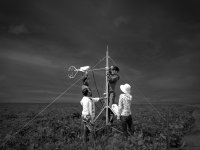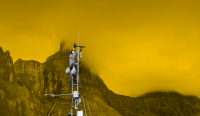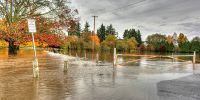Sensor Topics Your source for sensor-related articles
Displaying 1 - 20 of 36 articles
Seeing the Unseen: 3 Best Practices to Optimize Your Eddy Flux Measurements
Author: Aspen Nielsen | Last Updated: 10/14/2025 | Comments: 0
What is around you that you cannot see with your naked eye? This question might invoke images of distant galaxies, known only by state-of-the-art telescopes. Or, perhaps, you think about infrared or ultraviolet light, only visible through specialized cameras. Maybe microorganisms studied through a microscope in... read moreThe 0.1°C Challenge: The Heat on Temperature Sensors that Meet WMO Recommendations
Author: Aspen Nielsen | Last Updated: 08/22/2025 | Comments: 2
Whether you’re tracking climate change, assessing floods, monitoring glacial retreat, or making critical decisions about aircraft take-offs, temperature data play a central role. Air temperature directly influences a wide range of atmospheric and environmental conditions, including humidity, pressure, and wind patterns. Accurate temperature measurements are... read moreAWOS Explained: How These Systems Enhance Airport Safety and Efficiency
Author: Aspen Nielsen | Last Updated: 07/16/2025 | Comments: 0
As an aviation professional, when you think about weather safety, what comes to mind? Maybe you think about managing growing stacks of flights at various altitudes while anxiously awaiting clearer weather for safe landings. Or maybe you are concerned about aircraft braking performance affected by water... read moreBreaking Down the AtmosVue™30 Specifications (what they actually mean)
Author: Aspen Nielsen | Last Updated: 06/30/2025 | Comments: 0
When you look at a spec sheet for a weather sensor such as the AtmosVue™30, you’re typically presented with a lot of numbers and technical terms. For example, these might include: Present weather outputs Background luminance measurement range Operating temperature range But what does all this actually... read moreHow to Easily Replace and Update a CS223 Sensor Head
Author: Ajay Singh | Last Updated: 01/15/2024 | Comments: 0
Campbell Scientific’s CS223 Pt-1000 Class A, Back-of-Module Temperature Sensor (discontinued effective 31 October 2023) has been replaced by the CS241 Pt-1000 Class A, Back-of-Module Temperature Sensor. When needed, you can replace the CS223 sensor head with a CS241 head without having to replace the entire... read moreHow the DustVue Can Help You Get USABLE Soiling Data
Author: Ben Todt | Last Updated: 12/04/2023 | Comments: 0
Should you be concerned about the impact of soiling or fouling on your photovoltaic (PV) power plant performance? Did you know that in a recent estimate, more than US$6 billion of annual revenue is lost because of diminished power generation at PV facilities due to... read moreGet the Most out of VSPECT®
Author: Jacqalyn Maughan | Last Updated: 08/22/2023 | Comments: 3
Understanding the benefits of VSPECT® will help ensure you are maximizing your benefits when using this technology. In this article, we’ll explore this topic to provide you with a better measurement experience. Why do Campbell Scientific monitoring platforms give me extra vibrating wire data? Have you ever... read moreUse VSPECT® to Verify: Bad Sensors or Bad Data?
Author: Jacqalyn Maughan | Last Updated: 04/06/2023 | Comments: 0
Have you ever thought your bad vibrating wire sensor measurements were caused by erratic or erroneous data? You may be surprised to learn that data issues may not be the cause. If you are using a data-acquisition system other than one of the Campbell Scientific... read moreTroubleshooting Vibrating Wire Piezometers
Author: Nathanael Wright | Last Updated: 03/28/2023 | Comments: 0
Campbell Scientific vibrating wire measurement hardware, with our patented VSPECT® technology, offers a distinct advantage over all other vibrating wire measurement systems. Unlike non-Campbell Scientific vibrating wire interfaces that use pulse counting to derive vibrating wire frequency, Campbell Scientific's VSPECT vibrating wire measurement products use spectral... read moreDeath Valley, a Year Later
Author: Dirk Baker | Last Updated: 07/29/2022 | Comments: 9
About a year ago (May 2021), I installed a weather station next to the National Weather Service’s (NWS) official station at Furnace Creek in Death Valley National Park (California, USA). To familiarize yourself with this project, read my previous article. The purposes of this installation... read moreWhich surface temperature sensor is best for your application?
Author: Libbie Anderson | Last Updated: 05/05/2022 | Comments: 0
At Campbell Scientific, we redesigned our back-of-module temperature sensors and launched the CS241 and CS241DM purpose-built sensors to optimize performance on bifacial photovoltaic (PV) modules and help you collect data as precisely as possible. These newer sensors have some similarities to our previous sensor models, but... read moreBut It’s a Dry Heat… like a Furnace
Author: Dirk Baker | Last Updated: 06/21/2021 | Comments: 6
In this article, I'll share my experience collaborating on a research project to record some extreme weather conditions that may even set a world record! On August 16, 2020, the weather station located at Furnace Creek in Death Valley National Park (California, USA) recorded a temperature... read moreWhy Do We Need an Algorithm for Rainfall Intensity Correction?
Author: Dirk Baker | Last Updated: 03/05/2021 | Comments: 0
In this article, I’ll explain how errors can occur when measuring the precipitation amount, discuss a correction approach, and demonstrate how an algorithm can be used to design high-quality tipping bucket rain gauges. Introduction Liquid precipitation (rain) is at once one of the simplest measurements mechanically and... read moreMonitoring the Performance of Bifacial Solar PV Panels: Challenges and Opportunity
Author: Ajay Singh | Last Updated: 10/13/2020 | Comments: 0
When we are faced with challenges, there is often an opportunity for improvement. In this blog article, learn how our engineers redesigned our back-of-module (BOM) temperature sensor to resolve specific challenges that impacted the quality of bifacial solar photovoltaic (PV) panel performance monitoring. Bifacial PV panels... read moreMaking Real-Time Crest Measurements
Author: Mike Nelson | Last Updated: 09/08/2020 | Comments: 0
There are times during major weather events when we may hear the news reporter indicate the local river is expected to crest in the next 12 hours at an estimated stage level. What is a crest and a stage level, and how do they affect me? Basically,... read moreRelative Humidity: To Average, or Not to Average?
Author: Dirk Baker | Last Updated: 01/30/2020 | Comments: 2
Have you ever been told not to average relative humidity (RH)? Have you ever created a data logger program with Short Cut and noticed that it does not allow you to average RH when you generate your data table? Do you know why? In this blog... read moreEvolution Not Revolution: Updating an Established Product Range
Author: Andrew Sandford | Last Updated: 01/06/2020 | Comments: 0
Imagine that you already have a winning sensor that has sold more than 15,000 units. As time passes, you realize that technology has evolved, but your sensor hasn’t. If you are objective in your product evaluation, you may determine that there is justification for the... read moreWhy Should You Use a Heated Sonic Anemometer?
Author: Robin Deissinger | Last Updated: 11/19/2019 | Comments: 0
Are you ready to get heated? In this interview, Hayden Mahan, Product Manager of the Gas Flux and Turbulence Group, shares his excitement about our heated sonic anemometer (the new CSAT3BH) and why heat matters. Hayden was interviewed by Robin Deissinger, the blog editor. Interview... read moreSoil CO2 Flux Measurements Made Easy
Author: Robin Deissinger | Last Updated: 06/24/2019 | Comments: 0
Patented technology enables a new sensor to measure soil CO2 flux directly, providing you with new flexibility to make your measurements. In this interview, Hayden Mahan, Gas Flux and Turbulence Product Manager, introduces us to the eosFD and explains how this sensor works. Hayden was... read moreTaking In-Situ Soil Measurements to New Performance Depths
Author: Dirk Baker | Last Updated: 04/17/2019 | Comments: 0
Advances in technology and mechanical design offer vast improvements for those of you who need soil measurements at multiple depths—especially environmental researchers and anyone who works with environmental monitoring networks. In this article, we’ll take a closer look at the measurement challenges you may face... read more






























